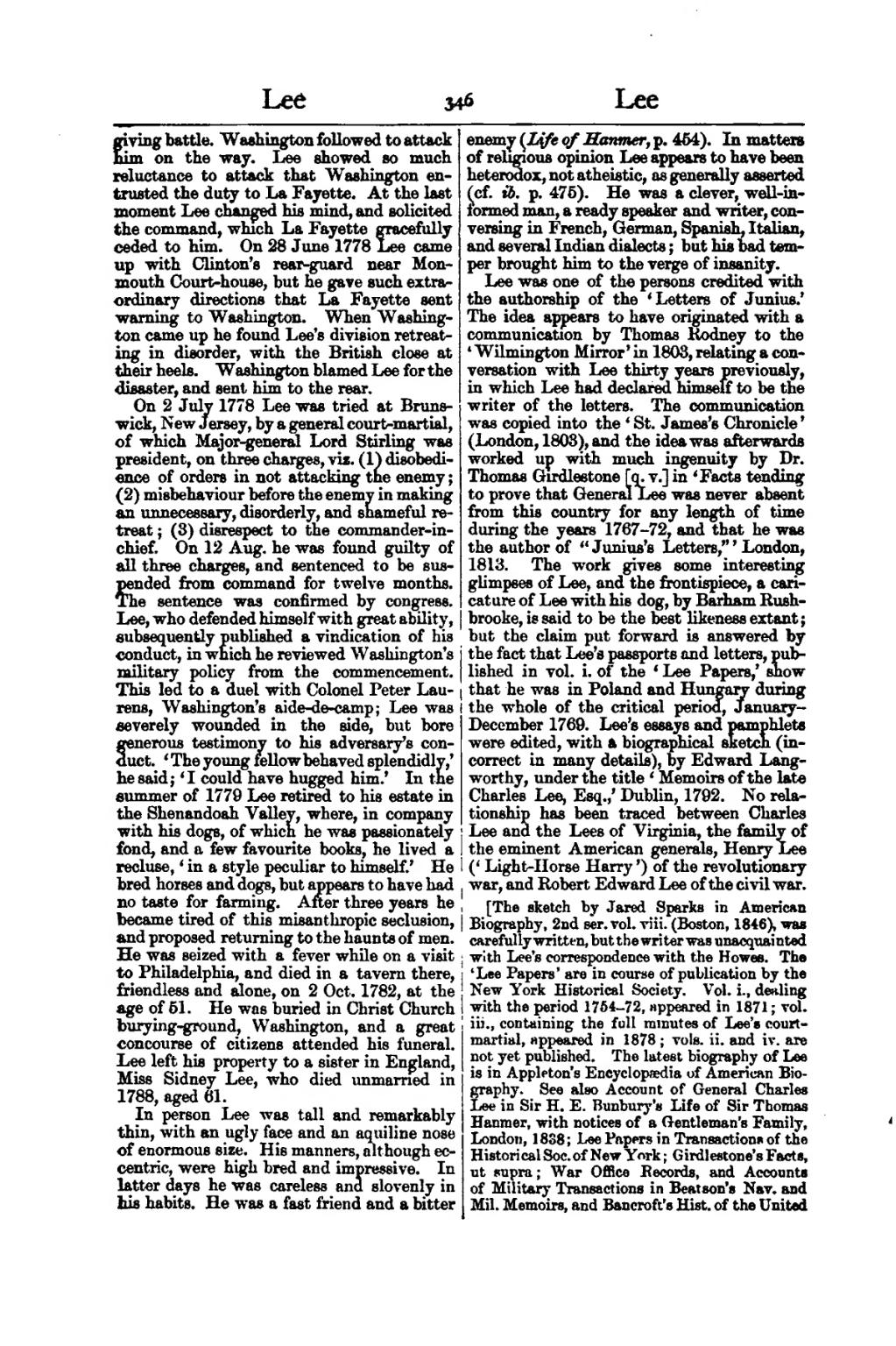giving battle. Washington followed to attack him on the way. Lee showed so much reluctance to attack that Washington entrusted the duty to La Fayette. At the last moment Lee changed his mind, and solicited the command, which La Fayette gracefully ceded to him. On 28 June 1778 Lee came up with Clinton's rear-guard near Monmouth Courthouse, but he gave such extraordinary directions that La Fayette sent warning to Washington. When Washington came up he found Lee's division retreating in disorder, with the British close at their heels. Washington blamed Lee for the disaster, and sent him to the rear.
On 2 July 1778 Lee was tried at Brunswick, New Jersey, by a general court-martial, of which Major-general Lord Stirling was president, on three charges, vie. (1) disobedience of orders in not attacking the enemy ; (2) misbehaviour before the enemy in making an unnecessary, disorderly, and shameful retreat ; (3) disrespect to the commander-in- chief. On 12 Aug, he was found guilty of all three charges, and sentenced to be suspended from command for twelve months. The sentence was confirmed by congress. Lee, who defended himself with great ability, subsequently published a vindication of his conduct, in which he reviewed Washington's military policy from the commencement. This led to a duel with Colonel Peter Laurens, Washington's aide-de-camp; Lee was severely wounded in the side, but bore generous testimony to his adversary's conduct. 'The young fellow behaved splendidly.' he said; 'I could have hugged him.' In the summer of 1779 Lee retired to his estate in the Shenandoah Valley, where, in company with his dogs, of which he was passionately fond, and a few favourite books, he lived a recluse, 'in a style peculiar to himself.' He bred horses and dogs, but appears to have had no taste for fanning. After three years he became tired of this misanthropic seclusion, and proposed returning to the haunts of men. He was seized with a fever while on a visit to Philadelphia, and died in a tavern there, friendless and alone, on 2 Oct. 1782, at the age of 51. He was buried in Christ Church burying-ground, Washington, and a great concourse of citizens attended his funeral. Lee left his property to a sister in England, Miss Sidney Lee, who died unmarried in 1788, aged 61.
In person Lee was tall and remarkably thin, with an ugly face and an aquiline nose of enormous size. His manners, although eccentric, were high bred and impressive. In latter days he was careless and slovenly in his habits. He was a fast friend and a bitter enemy (Life of Hanmer, p. 454). In matters of religious opinion Lee appears to have been heterodox, not atheistic, as generally asserted (cf. ib. p. 475). He was a clever, well-informed man, a ready speaker and writer, conversing in French, German, Spanish. Italian, and several Indian dialects ; but his bad temper brought him to the verge of insanity.
Lee was one of the persons credited with the authorship of the 'Letters of Junius.' The idea appears to have originated with a communication by Thomas Rodney to the 'Wilmington Mirror' in 1803, relating a conversation with Lee thirty years previously, in which Lee had declared himself to be the writer of the letters. The communication was copied into the 'St. James's Chronicle' (London, 1803), and the idea was afterwards worked up with much ingenuity by Dr. Thomas Girdlestone [q.v.] in 'Facts tending to prove that General Lee was never absent from this country for any length of time during the years 1767-72, and that he was the author of "Junius's Letters," ' London, 1813. The work gives some interesting glimpses of Lee, and the frontispiece, a caricature of Lee with his dog, by Barham Rushbrooke, is said to be the best likeness extant; but the claim put forward is answered by the fact that Lee's passports and letters, published in vol. i. of the 'Lee Papers,' snow that he was in Poland and Hungary during the whole of the critical period, January-December 1769. Lee's essays and pamphlets were edited, with a biographical sketch (incorrect in many details), by Edward Langworthy, under the title 'Memoirs of the late Charles Lee, Esq..' Dublin, 1792. No relationship has been traced between Charles Lee and the Lees of Virginia, the family of the eminent American generals, Henry Lee ('Light-Horse Harry') of the revolutionary war, and Robert Edward Lee of the civil war.
